Giochi dell'Oca e di percorso
(by Luigi Ciompi & Adrian Seville)
(by Luigi Ciompi & Adrian Seville)

|
Giochi dell'Oca e di percorso
(by Luigi Ciompi & Adrian Seville) |

|
 |

Torna alla ricerca giochi (back to game search) |
 |
| New (The) Game of Virtue Rewarded and Vice Punished. For the Amusement of Youth of Both Sexes. | ||
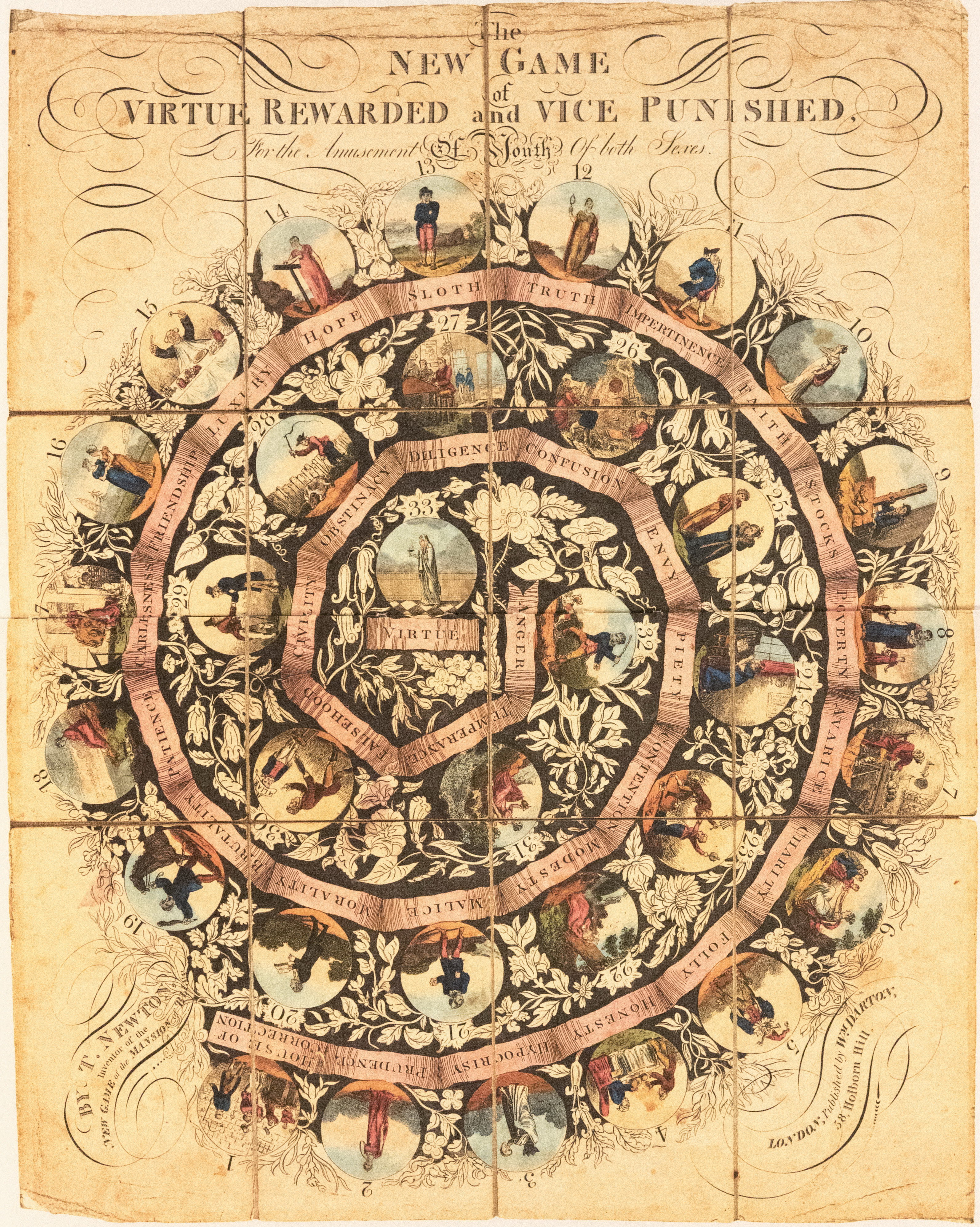 |
Versione stampabile
 |
Invia una segnalazione

|
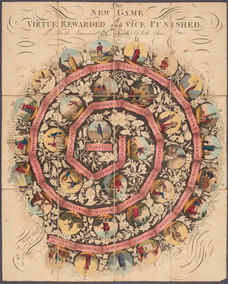 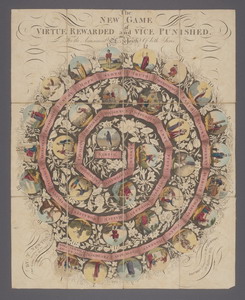  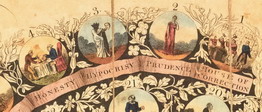 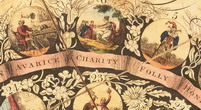 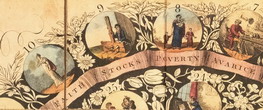 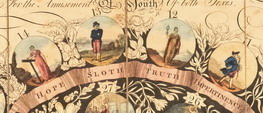 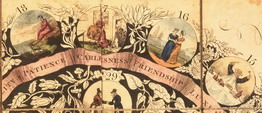  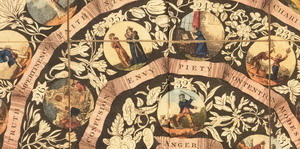 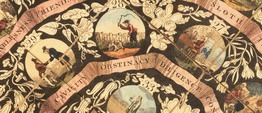  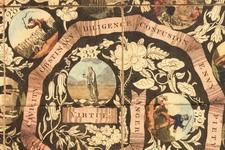 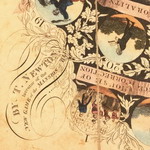 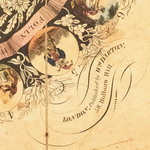 |
primo autore: | Newton Thomas |
| secondo autore: | Darton William | |
| anno: | 1818 | |
| luogo: |
Inghilterra-Londra |
|
| periodo: | XIX secolo (1°/4) | |
| percorso: | Percorso di 33 caselle numerate | |
| materiale: | carta incollata su tela (engraving on paper with linen backing) | |
| dimensioni: | 572X447 | |
| stampa: | Litografia colorata a mano (hand coloured engraving) | |
| luogo acquisto: | ||
| data acquisto: | ||
| dimensioni confezione: | ||
| numero caselle: | 33 | |
| categoria: | Infanzia, educazione, pedagogia, favole e fiabe | |
| tipo di gioco: | Gioco di percorso | |
| editore: | Published by W.m Darton 58 Holborne Hill | |
| stampatore: | Printed by W. Darton Jun., 58 Holborn Hill | |
| proprietario: | Collezione Privata | |
| autore delle foto: | L. Ciompi (da "Goodfellow C.) | |
| numero di catalogo: | 1375 | |
| descrizione: |
Gioco di 33 caselle numerate, spirale, antiorario, centripeto. REGOLE: non riportate sul tavoliere. CASELLE: con didascalia. REFERENZA 1 "The New Game of Virtue Rewarded and Vice Punished. For the Amusement of Youth of Both Sexes". (V&A Museum). Moral games were particularly popular in the 19th century. The 33 playing spaces on this example are named for virtues such as Faith, Hope and Charity, and vices such as Folly, Malice and Envy. The game would have been played with a teetotum, an early form of dice in the shape of a spinner. The players begin on the first space, the House of Correction, and the winner is the first to land on the last space: Virtue. Physical description Design: etching, coloured by hand, 12 sections mounted on linen, showing 33 medallions. N°of squares: 33 Squares illustrated: all Square numbering: all Squares titled: in booklet Subject of starting square: House of Correction Subject of ending square: Virtue Place of Origin: London Date: 1818 Artist/maker: Darton, William Materials and Techniques: Hand coloured paper on linen Dimensions: Width: 22.5 in; height: 17.6 in Historical context note Rewards: receipt of counters, forward movement and extra turns Forfeits: payment of counters, backward movement, missing turns N°of Players: 2 to 12 Equipment required: teetotum, markers and counters (12 each). Rules: THE NEW GAME OF VIRTUE REWARDED AND VICE PUNISHED FOR THE AMUSEMENT OF YOUTH OF BOTH SEXES. IT IS DESIGNED WITH A VIEW TO PROMOTE THE PROGRESSIVE IMPROVEMENT OF THE JUVENILE MIND, AND TO DETER THEM FROM PURSUING THE DANGEROUS PATHS OF VICE. BY T NEWTON LONDON: PRINTED BY W DARTON JUN 58 HOLBORN HILL 1818 (Also with an advertisement for the publishing of The Mansion of Bliss by T. Newton, published by Darton). RULES FOR PLAYING I. This game is played with a tetotum (spelling) marked 1,2,3,4; and any number of persons, from two to twelve, may partake of it. II. Each player must be provided with twelve counters and a mark; each mark varying in colour, that every one may know their own. III. Each player must put four counters into the bank before the game be commenced. IV. When it has been agreed who shall begin the game, the first person, having spun the Tetotum, must place his mark upon the number corresponding with that the Tetotum presents uppermost. If a 3 be spun, he must place his mark upon Hypocrisy, which directs him to forfeit two counters into the bank and one to each player. When it comes to his turn to spin again, and a 2 turn up, he must then place his mark upon Folly, and act as the rule No. 5 directs. The mark must be placed as many steps forward as the Tetotum represents. V. If any player should turn to a number which sends him back to another, he must not suffer as that figure directs; viz. Falsehood is sent to the Stocks, and must remain there, whilst every other player turns three times; but he must pay any attention to the rule Stocks represent. VI. If any player should turn up a number which would carry him beyond Virtue as many numbers as he turns beyond it, he must go back from the figure he last turned from viz. if his mark be on Temperance, and he should turn up a 4, he would turn one beyond Virtue, he must then place his mark back upon Falsehood, and remain till his turn come again. DIRECTIONS I. House of Correction. Whoever gets into this must wait while every other players turns three times. II. Prudence. Is to have the privilege of turning again. III. Hypocrisy. Must forfeit two counters into the back and one to each player. IV. Honesty. Must receive one counter from each player. V. Folly. Must pay two counters into the back and turn again. VI. Charity. Is allowed to turn three times successively. VII. Avarice. Must forfeit half his counters into the bank. VIII. Poverty. Is to be relieved by two counters from the bank. IX. The Stocks. Whoever gets into the Stocks must wait whilst every other player turns twice. X. Faith. Claims one counter from each player. XI. Impertinence. Must go back to Prudence to learn good manners. XII. Truth. Must receive four counters from the bank and one from each player. XIII, Sloth. Must be sent to the House of Correction and wait while every other player turns twice. XIV. Hope. Must wait with patience until the next turn. XV. Luxury. Must pay one counter into the bank and one to each player. XVI. Friendship. Is to have the privilege of turning again. XVII. Carelessness. Must be sent back to Prudence. XVIII. Patience. Claims three counters from the bank. XIX. Brutality. Must be sent to the House of Correction. XX. Morality. Is to receive one counter from each player. XXI. Malice. Must pay one counter to each player and one into the bank. XXII. Modesty. Is entitled to turn again. XXIII. Contention. Must forfeit one counter to each player and turn again. XXIV. Piety. Is allowed to advance to Temperance. XXV. Envy. Must wait while every other player turns twice. XXVI. Confusion. Must go back to the number he last turned from. XXVII. Diligence. Must be rewarded with one counter from each player and turn again. XXVIII. Obstinacy. Must go back to Patience and pay two counters into the bank. XXIX. Civility. May advance two steps. XXX. Falsehood. Must be put in the Stocks while every player turns three times. XXXI. Temperance. Is allowed the privilege of turning again. XXXII. Anger. Must go back to Patience and remain while every player turns twice. XXXIII. Virtue. Claims the contents of the bank and wins the game. FINIS Rules placement: booklet Descriptive line: Hand coloured paper on linen game of Virtue Rewarded and Vice Punished, published in England by William Darton in 1818 REFERENZA 2 WHITEHOUSE, Francis Reginald Beaman, (pag. 50): VIRTUE REWARDED AND VICE PUNISHED (The new game of). For the Amusement of Youth of both Sexes. By T. NEWTON, Inventor of the new game of “The Mansion of Bliss". London. Published by Wm. Darton, 58, Holborn Hill. An engraving size 18 in X 22 ½ in, hand-coloured, mounted in 12 sections on linen and contained in slip-in case with label on the front, giving the full title. Price 6s. The game is a race from No 1 "House of Correction” to 33 “Virtue” The book of rules states “lt is designed with a view to promoting progressive Improvement of the Juvenile Mind, and to deter them from pursuing the dangerous Paths of Vice” Printed by W. Darton Jun., 58 Holborn Hill, 1818. REFERENZA 3 "Deux autres jeux dont l'inventeur Thomas Newton est connu, furent publiés en 1818 et 1822 par William Darton. Le plus ancien porte le fameux titre Vertu récompensée et vice puni. Il a 33 médaillons, répresentant le bon et le mauvais coté des caractères humains et le jeu est conçu pour l'amusement de la jeunesse "avec le but de promouvoir l'amélioration progressive des jeunes esprits et de les dissuader de suivre les dangereuses voies du vice." (GOODFELLOW Caroline) REFERENZA 4 "Two other of which the inventor, Thomas Newton, is known, were published in 1818 and 1822 by William Darton. The earlier of the two bears the famous title Virtue Rewarded and Vice Punished. It has 33 medallions representing good and bad human characteristics and the game was designed for the amusement of youth "with a view to promote the progressive improvement of the juvenile mind and to deter them from pursuing the dangerous paths of vice"." (GOODFELLOW Caroline) REFERENZA 5 The New Game of Virtue Rewarded und Vice Punished - Das neue Spiel: Lohn der Tugend und Strafe dem Laster London, 1818 Radierung, handkoloriert, 57.15X44.7 cm Verlag: William Darton Verfasser; T. Newton, London Sammlung: Victoria and Albert Museum, London (Inv.-Nr.: MISC.37-1961) Dass Tugend und Laster nicht trennscharf geschieden sind, dass ein tugendhaftes Leben nicht immer wie von selbst auch das richtige Leben ist, und dass ein gewisses Mass an Lasterhaftigkeit und Unvernunft mitunter durchaus angemessen, ja vernuenftig ist - das ist nicht erst eine Erfahrung des 20. oder 21. Jahrhunderts. Es ist eine Einsicht in die Fehlbarkeit des Menschen, die Skeptiker und Skeptikerinnen zu allen Zeiten gemacht haben. Schon Michel de Montaigne (1533-1592) spricht von den "ganz normalen Lastern" des Menschen. Wie Viele moralisierende Spiele formuliert The New Game of Virtue Rewarded and Vice Punished eine strenge Gegenposition zu derlei Milde. Es praesentiert eine einfache, scheinbar wohlgeordnete Welt, in der Gut und Boese, Tugend und Laster zwar nebeneinander liegen, aber klar unterscheidbar sind. Die Simplifizierung der Welt und die Imagination von Ordnung ist dem Spiel nicht vorzuwerfen, es ist seine Funktion. Bei genauerern Hinsehen erweist sich das praechtige Spiel mit seinen floralen Mustern und seiner perfekten Ordnung als Durcheinander, kompiliert aus Versatzstuecken aus dem christlichen Tugendkatalog des Mittelalters, antiken Tugenden und allgemeinen ethischen Praemissen. Der wilde Mix hatte eine Funktion: Er formte in der noch jungen Kultur der Buergerlichkeit die "innerliche Okonomie", die etwa das Handbuch der Moral fuer den Buergerstand von Carl Friedrich Bahrdt im Revolutionsjahr 1789 fuer das Leben des aufgeklaerten Buergers fordert. Oekonomisch nuetzliche Tugenden wie Fleiss (27), Vermeidung von Traegheit (13) oder Von Luxus (15) sollen vom Buerger verinnerlicht und weit ueber die Geschaeftsfuehrung hinaus auf alle Bereiche im privaten Leben uebertragen werden. Durch die Verbindung mit aristokratischen Tugenden wie Besonnenheit (2) und sozialen Werten Wie Wohltaetigkeit (6) und Bescheidenheit (22) bei gleichzeitiger Vermeidung von Habgier (7) oder Falschheit (30) wird das Streben nach dem "eigenen Vortheil" zugunsten "des Endzwecks des gerneinschaftlichen Besten" begrenzt, wie es in Johann Heinrich Gottlob von Justis Traktat Die Grundfeste zu der Macht und Glueckseeligkeit der Staaten aus dem Jahr 1761 heist. Der eklektizistische Katalog formiert ein moralisches Ganzes des richtigen Lebens. Der Selbstwiderspruch des moralisierenden Spiels wird auch hier transparent: Wie die meisten Spiele der Zeit wurde wohl auch Virtue Rewarded and Vice Punished um reale Einsaetze gespielt. Wer also das Pech hatte und staendig auf negative Felder geriet, konnte vom Tugendhaften, der - als Erster im Ziel - den lnhalt der Kassa erhielt, richtig abgezockt werden. Ob der Gewinner danach ueber ausreichend Wohltaetigkeit (6), Freundschaft (16) oder Anstand (29) verfuegte, den Gewinn zu teilen, kann keineswegs als sicher gelten. Spielregeln und Felder Dieses Spiel wird mit einem Kreisel ("Teetotum") gespielt, der mit 1, 2, 3, 4 markiert ist (Anm.: Man kann auch einen Wuerfel verwenden und die Augenzahlen 5 und 6 vernachlaessigen oder Karten mir Zahlen ziehen); eine beliebige Anzahl von Spielern, von zwei bis zwoelf kann teilnehmen. Jeder Spieler erhaelt zwoelf Jetons, vier davon gibt er in die Kassa. Wenn ein Spieler von einem auf ein anderes Feld zurueckgeschickt wird, muss er den Anweisungen auf diesem Feld nicht Folge leisten. Das Ziel (Tugend) muss mit exakter Augenzahl erreicht werden. Ueberwirft der Spieler das Ziel, muss er die ueberschuessige Augenzahl von seinem Feld zurueckgehen. 1 Besserungsanstalt (House of Correction) 3 x aussetzen. 2 Besonnenheit (Prudence) - Noch einmal wuerfeln. 3 Heuchelei (Hypocrisy) - Zahlt 2 Jetons in die Kassa und 1 an jeden Spieler. 4 Ehrlichkeit (Honesty) - Erhaelt von jedem Spieler 1 Einsatz, 5 Torheit (Folly) - Zahlt 2 Jetons in die Kassa und wuerfelt noch einmal. 6 Wohltaetigkeit (Charity) - Darf 3 x wuerfeln. 7 Habgier (Avarice) - Zahlt die Haelfte seiner Jetons in die Kassa. 8 Armut (Poverty) - Erhaelt 2 Einsaetze aus der Kassa. 9 Pranger (The Stocks) - 2 X aussetzen. 10 Glaube (Faith) - Erhaelt von jedern Spieler 1 Einsatz. 11 Frechheit (Impertinence) - Muss zur Besonnenheit (2) zurueck, um gute Manieren zu lernen. 12 Wahrheit (Truth) - Erhaelt 4 Jetons aus der Kassa und 1 von jedem Spieler. 13 Traegheit (Sloth) - Geht in die Besserungsanstalt und setzt 2 X aus. 14 Hoffnung (Hope) - 1 x aussetzen. 15 Luxus (Luxury) - Zahlt je 1 Jeton in die Kassa und 1 an jeden Spieler. 16 Freundschaft (Friendship) - Noch einmal wuerfeln, 17 Gedankenlosigkeit (Carelessness) - Zieht zur Besonnenheit (2) zurueck. 18 Geduld (Patience) - Erhaelt 3 Spielrnarken aus der Kassa, 19 Brutalitaet (Brutality) - Wird in die Besserungsanstalt (1) geschickt. 20 Moral (Morality) - Erhaelt von jedem Spieler 1 Einsatz. 21 Boesartigkeit (Malice) - Zahlt jedem Spieler und der Bank 1 Einsatz. 22 Bescheidenheit (Modesty) - Noch einmal wuerfeln. 23 Disput (Contention) - Zahlt jedem Spieler und der Bank 1 Einsatz und wuerfelt erneut. 24 Gottesfurcht (Piety) - Rueckt zu Massigung (31) vor. 25 Neid (Envy) - Setzt 2 x aus. 26 Verwirrung (Confusion) - Muss auf das Feld zurueck, woher er gekommen ist. 27 Fleiss (Diligence) - Erhaelt von jedem Spieler 1 Einsatz und wuerfelt noch einmal. 28 Sturheit (Obstinacy) - Muss zu Geduld (18) zurueck und zahlt 2 Einsaetze in die Kassa. 29 Anstand (Civility) - Zieht 2 Felder vorwaerts. 30 Falschheit (Falsehood) - Muss zu Pranger (9) gebracht werden und setzt 3 x aus. 31 Maessigung (Temperance) - Darf noch einmal wuerfeln. 32 Zorn (Anger) - Muss zu Geduld (18) zurueck und setzt 2 x aus. 33 Tugend (Virtue) - Erhaelt den lnhalt der Kassa und gewinnt das Spiel. Exhibitions: - "Instruction and Delight: Children's Games from the Ellen and Arthur Liman Collection" (Yale Center for British Art, 17 January-23 May, 2019). |
|
| bibliografia: |
1) WHITEHAUSE, F.R.B.: "Table Games of Georgian and Victorian Days", London, Peter Garnett, 1951. 2) GOODFELLOW, Caroline: "A Collector's Guide to Games and Puzzles". Secaucus, New Jersey, Chartwell Books-London, Quintet Publishing Limited 1991. 3) GOODFELLOW, Caroline: "The Development of the English Board Game, 1770-1850", in Board Games Studies 1, 1998. 4) GOODFELLOW, Caroline: "Jeux de société. Le guide du collectionneur des jeux de société depuis le XVIIIe siècle jusqu’à nos jours", (Edizione francese) Carrousel MS, 2001. 5) SEVILLE, Adrian: "The Game of Goose: and its influence on cartographical race games" Journal of the International Map Collectors' Society, Winter 2008 N°115 2008. 6) SEVILLE, Adrian: "The geographical Jeux de l'Oie of Europe." In "Belgeo" 2008 3-4 2008. 7) GOODFELLOW, Caroline: "How We Played: Games From Childhood Past", History Press, 2012. 8) QUINN, Brian - CARTWRIGHT, William: "Geographic Board Games". Geospatial Science Research 3. School of Mathematical and Geospatial Science, RMIT University, Australia. December 2014. 9) SEVILLE, Adrian: "The Royal Game of the Goose four hundred years of printed Board Games". Catalogue of an Exhibition at the Grolier Club, February 23 - May 14, 2016. 10) LIMAN, Ellen: "Georgian and Victorian Board Games: The Liman Collection", Pointed Leaf Press, 2017. 11) NORCIA, Megan A.: "Gaming Empire in Children's British Board Games, 1836-1860". Studies in Childhood, 1700 to the Present. Routledge, 2019. |
|
| "The Development of the English Board Game", 1770-1850 (Caroline G. Goodfellow) | ||
| Games of Moral Improvement. "Table Games of Georgian and Victorian Days". (Francis Reginald Beaman, Whitehause) | ||
Vai alla ricerca giochi Vai all'elenco autori